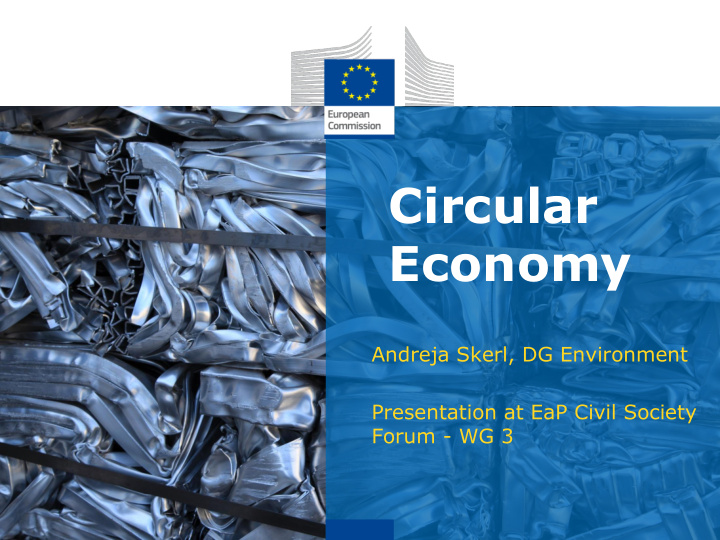



Circular Economy Andreja Skerl, DG Environment Presentation at EaP Civil Society Forum - WG 3
From a Linear Economy… NATURAL TAKE MAKE DISPOSE RESOURCES WASTE WASTE WASTE
to a Circular Economy • Circular economy systems keep the added value in products for as long as possible and eliminate waste . • They keep resources within the economy, so that they can be productively used again and again and hence create further value.
What are the limitations of a Linear Economy? • Lost value of materials and products • Scarcity of resources • Volatile prices of resources • Waste generated • Unstable supply of raw materials • Environmental degradation & climate change
What are the benefits of a Circular Economy? • The value of products, materials and resources is maintained in the economy for as long as possible • Waste generation is minimised • Boost to the economy and competitiveness by creating new business opportunities, and introducing innovative products and services • Brings economic, social and environmental gains
Circular Economy: looking to the future (EU example) • Growth and job creation – Up • Building economic and to +7 % GDP environmental resilience – Up to 600 billion in savings – 8 % of annual turnover for • Encouraging innovation business in the EU – Estimated 170 000 direct jobs in waste management sectors created by 2035 • Reducing total annual Greenhouse Gas Emissions by • Boosting competitiveness and 2-4 % ensuring security of supply
Circular Economy Package Adopted by the European Commission on 2nd December 2015
Circular Economy Package Action Plan List of Follow-up Legislative Communication Initiatives (Annex) proposals on waste
Links with Commission Priorities Protecting the environment and maintaining our competitiveness have to go hand-in-hand: both are about a sustainable future Jobs, Growth Democratic Energy Union and Change Better and Climate Investment Regulation Circular Economy
Key action areas Production Innovation, Secondary Investment Consumption raw materials & Monitoring Waste Management
Key actions include: • Funding of over €650 million under Horizon 2020 and €5.5 billion under the structural funds; • Actions to reduce food waste including a common measurement methodology, improved date marking, and tools to meet the global Sustainable Development Goal to halve food waste by 2030 ; • Measures in the Ecodesign working plan for 2015-2017 to promote reparability, durability and recyclability of products, in addition to energy efficiency; • A revised Regulation on fertilisers ; • A strategy on plastics in the circular economy ; A series of actions on water reuse including a legislative proposal on minimum • requirements for the reuse of wastewater. The Communication includes a clear timeline for the actions proposed and a plan for a simple and effective monitoring framework for the circular economy. 11
Production Objectives Key actions • Provide incentives • Reparability, durability, and recyclability in to boost circular eco-design (e.g. TV screens) product design • Innovative and • Best practices for waste management and efficient production resource efficiency in industrial sectors processes • Industrial symbiosis
Consumption Objectives Key actions • Repair and reuse of • Encourage reuse activities (e.g. waste proposal) products to avoid • Ecodesign: availability of spare parts waste generation • Guarantees and action on false green claims • Circular Economy criteria in Green Public • Provide consumers Procurement with reliable • Independent testing programme to assess information on possible planned obsolescence environmental • Better labelling: EU Eco-label, Environmental impact of products Footprint
Waste management Objectives Key actions • Improve waste • Legislative proposals on waste management in line with the EU waste • Work with Member States to improve waste hierarchy management plans, including to avoid overcapacity in residual waste treatment • Address existing (incineration and mechanical-biological implementation treatment) gaps • Ensure coherence between waste investments • Provide long-term under EU Cohesion Policy and the waste vision and targets hierarchy to guide investments
Market for secondary raw materials Objectives Key actions • Increase the use of secondary • Quality standards for secondary raw materials raw materials • EU regulation on fertilisers • Increase the use of recycled nutrients and the reuse of treated wastewater • Legislative proposal on minimum requirements for reused water • Safely manage risks of chemicals of concern • Analysis on the interface between chemicals, product, and waste legislation • Improve knowledge of material stocks and flows • EU-wide electronic system for cross-border transfers of waste
Waste management aspects
Common EU target for recycling 65% of municipal waste by 2030 17
New targets municipal waste - recycling 60% • One calculation method (method 4) 50% based on effective recycling by 2025 40% • Possible 5-year 30% extension for 7 MS recycling less than 20% 20% in 2013 10% • Review clause (2025) to consider 0% more stringent 2014 2025 target 2030 target targets % preparation for reuse and recycling (1 method)
New binding target to reduce landfill to a maximum of 10% of total waste by 2030 19
New targets municipal waste - landfilling 35% • By 2030 : max 10% 30% landfilling of MSW 25% • Possible 5-year time 20% extension for the same 7 MS as for the 15% recycling rate 10% • Review clause (2025) 5% to consider more stringent targets 0% 2013 (reported) Objective 2030 % Municipal waste in landfill
Common EU target for recycling 75% of packaging waste by 2030 21
New targets – packaging waste recycling 90% 80% % Prep for resue and recycling 70% 60% 50% 40% 30% 20% 10% 0% Existing targets 2012 (latest data) Target 2025 Target 2030 Plastic Wood Ferrous metal Aluminium Glass Paper and cardboard Overall → Clarification on measuring (same as for municipal waste) → Repeal of the recovery and max recycling targets → New target for aluminium
Thank you! http://ec.europa.eu/environment/circular -economy/index_en.htm 23
Recommend
More recommend